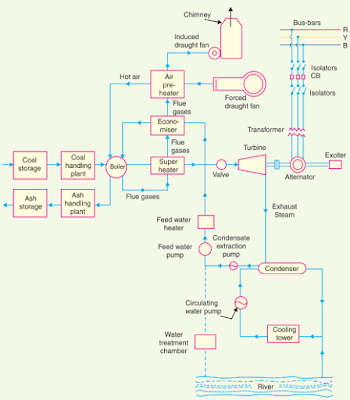In this article, we will study about the Thermal Power Plant.
A steam power station basically works on the Rankine cycle. Steam is produced in the boiler by utilising the heat of coal combustion. The steam is then expanded in the prime mover (i.e., steam turbine) and is condensed in a condenser to be fed into the boiler again. The steam turbine drives the alternator which converts mechanical energy of the turbine into electrical energy. This type of power station is suitable where coal and water are available in abundance and a large amount of electric power is to be generated.
SCHEMATIC ARRANGEMENT OF THERMAL POWER PLANT
The whole arrangement can be divided into the following stages for the sake of simplicity :
1. Coal and ash handling arrangement
2. Steam generating plant
3. Steam turbine
4. Alternator
5. Feed water
6. Cooling arrangement
SCHEMATIC ARRANGEMENT OF THERMAL POWER PLANT
1. Coal and ash handling plant-
The coal is transported to the power station by road or rail and
is stored in the coal storage plant. Storage of coal is primarily a matter of protection against coal
strikes, failure of transportation system and general coal shortages. From the coal storage plant, coal
is delivered to the coal handling plant where it is pulverised (i.e., crushed into small pieces) in order
to increase its surface exposure, thus promoting rapid combustion without using large quantity of excess air. The pulverised coal is fed to the boiler by belt conveyors. The coal is burnt in the boiler
and the ash produced after the complete combustion of coal is removed to the ash handling plant and
then delivered to the ash storage plant for disposal. The removal of the ash from the boiler furnace is
necessary for proper burning of coal.
2. Steam generating plant-
The steam generating plant consists of a boiler for the production of
steam and other auxiliary equipment for the utilisation of flue gases.
(i) Boiler- The heat of combustion of coal in the boiler is utilised to convert water into steam at
high temperature and pressure. The flue gases from the boiler make their journey through superheater, economiser, air pre-heater and are finally exhausted to atmosphere through the chimney.
(ii) Superheater- The steam produced in the boiler is wet and is passed through a superheater
where it is dried and superheated (i.e., steam temperature increased above that of boiling point of
water) by the flue gases on their way to chimney. Superheating provides two principal benefits.
Firstly, the overall efficiency is increased. Secondly, too much condensation in the last stages of
turbine (which would cause blade corrosion) is avoided. The superheated steam from the superheater
is fed to steam turbine through the main valve.
(iii) Economiser- An economiser is essentially a feed water heater and derives heat from the flue
gases for this purpose. The feed water is fed to the economiser before supplying to the boiler. The
economiser extracts a part of heat of flue gases to increase the feed water temperature.
(iv) Air preheater- An air preheater increases the temperature of the air supplied for coal burning by deriving heat from flue gases. Air is drawn from the atmosphere by a forced draught fan and
is passed through air preheater before supplying to the boiler furnace. The air preheater extracts heat
from flue gases and increases the temperature of air used for coal combustion. The principal benefits
of preheating the air are : increased thermal efficiency and increased steam capacity per square metre
of boiler surface.
3. Steam turbine
The dry and superheated steam from the superheater is fed to the steam
turbine through main valve. The heat energy of steam when passing over the blades of turbine is
converted into mechanical energy. After giving heat energy to the turbine, the steam is exhausted to
the condenser which condenses the exhausted steam by means of cold water circulation.
4. Alternator
The steam turbine is coupled to an alternator. The alternator converts mechanical
energy of turbine into electrical energy. The electrical output from the alternator is delivered to the
bus bars through transformer, circuit breakers and isolators.
5. Feed water
The condensate from the condenser is used as feed water to the boiler. Some
water may be lost in the cycle which is suitably made up from external source. The feed water on its
way to the boiler is heated by water heaters and economiser. This helps in raising the overall efficiency of the plant.
6. Cooling arrangement
In order to improve the efficiency of the plant, the steam exhausted
from the turbine is condensed* by means of a condenser. Water is drawn from a natural source of
supply such as a river, canal or lake and is circulated through the condenser. The circulating water
takes up the heat of the exhausted steam and itself becomes hot. This hot water coming out from the
condenser is discharged at a suitable location down the river.
ADVANTAGES OF THERMAL POWER PLANT
(i) The fuel (i.e., coal) used is quite cheap.
(ii) Less initial cost as compared to other generating stations.
(iii) It can be installed at any place irrespective of the existence of coal. The coal can be transported to the site of the plant by rail or road.
(iv) It requires less space as compared to the hydroelectric power station.
(v) The cost of generation is lesser than that of the diesel power station.
DISADVANTAGES OF THERMAL POWER PLANT
(i) It pollutes the atmosphere due to the production of large amount of smoke and fumes.
(ii) It is costlier in running cost as compared to hydroelectric plant.
Thanks for reading.
Keep sharing and loving.
